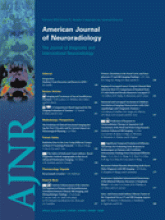Research ArticleInterventional
Rest versus Exercise Hemodynamics for Middle Cerebral Artery Aneurysms: A Computational Study
T.J. Bowker, P.N. Watton, P.E. Summers, J.V. Byrne and Y. Ventikos
American Journal of Neuroradiology February 2010, 31 (2) 317-323; DOI: https://doi.org/10.3174/ajnr.A1797
T.J. Bowker
P.N. Watton
P.E. Summers
J.V. Byrne

References
- 1.↵
- Brisman JL,
- Song JK,
- Newell DW
- 2.↵
- Myers J
- 3.↵
- Taylor CA,
- Hughes TJ,
- Zarins CK
- 4.↵
- Gupta V,
- Grande-Allen KJ
- 5.↵
- Poulin MJ,
- Syed RJ,
- Robbins PA
- 6.↵
- Moraine JJ,
- Lamotte M,
- Berre J,
- et al
- 7.↵
- Nichols WW,
- O'Rourke MF,
- McDonald DA
- 8.↵
- Cebral JR,
- Castro MA,
- Appanaboyina S,
- et al
- 9.↵
- Perktold K,
- Peter R,
- Resch M
- 10.↵
- Martin DG,
- Ferguson EW,
- Wigutoff S,
- et al
- 11.↵
- Patankar SV
- 12.↵
- Hellstrom G,
- Fischer-Colbrie W,
- Wahlgren NG,
- et al.
- 13.↵
- Gosling RG,
- King DH,
- Marcus AW,
- et al
- 14.↵
- Ku DN,
- Giddens DP,
- Phillips DJ,
- et al
- 15.↵
- Himburg HA,
- Grzybowski DM,
- Hazel AL,
- et al
- 16.↵
- Hollnagel DI,
- Summers PE,
- Kollias SS,
- et al
- 17.↵
- Ford MD,
- Nikolov HN,
- Milner JS,
- et al
- 18.↵
- Ujiie H,
- Tamano Y,
- Sasaki K,
- et al
- 19.↵
- 20.↵
- Tateshima S,
- Murayama Y,
- Villablanca JP,
- et al
- 21.↵
- Armando M,
- Xiaoping PH
- Cebral JR,
- Radaelli A,
- Frangi A,
- et al
- 22.↵
- Satoh T,
- Omi M,
- Ohsako C,
- et al
- 23.↵
- Shojima M,
- Oshima M,
- Takagi K,
- et al
- 24.↵
- Fogelholm RR,
- Turjanmaa VM,
- Nuutila MT,
- et al
- 25.↵
- Haykowsky MJ,
- Findlay JM,
- Ignaszewski AP
- 26.↵
- 27.↵
- Littler WA,
- Honour AJ,
- Sleight P
- 28.↵
- Kataoka K,
- Taneda M,
- Asai T,
- et al
- 29.↵
- Lasheras JC
- 30.↵
- Chien S
- 31.↵
- 32.↵
- Shojima M,
- Oshima M,
- Takagi K,
- et al
- 33.↵
- Meng H,
- Wang Z,
- Hoi Y,
- et al
- 34.↵
- Chien S
- 35.↵
- Butty VD,
- Gudjonsson K,
- Buchel P,
- et al
In this issue
Advertisement
T.J. Bowker, P.N. Watton, P.E. Summers, J.V. Byrne, Y. Ventikos
Rest versus Exercise Hemodynamics for Middle Cerebral Artery Aneurysms: A Computational Study
American Journal of Neuroradiology Feb 2010, 31 (2) 317-323; DOI: 10.3174/ajnr.A1797
0 Responses
Jump to section
Related Articles
Cited By...
This article has been cited by the following articles in journals that are participating in Crossref Cited-by Linking.
- Kristian Valen-Sendstad, Marina Piccinelli, Resmi KrishnankuttyRema, David. A. SteinmanAnnals of Biomedical Engineering 2015 43 6
- A.J. Geers, I. Larrabide, H.G. Morales, A.F. FrangiJournal of Biomechanics 2014 47 1
- A.J. Geers, I. Larrabide, A.G. Radaelli, H. Bogunovic, M. Kim, H.A.F. Gratama van Andel, C.B. Majoie, E. VanBavel, A.F. FrangiAmerican Journal of Neuroradiology 2011 32 3
- P. N. Watton, A. Selimovic, N. B. Raberger, P. Huang, G. A. Holzapfel, Y. VentikosBiomechanics and Modeling in Mechanobiology 2011 10 1
- Alexandra Lauric, James Hippelheuser, Mina G. Safain, Adel M. MalekJournal of Biomechanics 2014 47 12
- Alexandra Lauric, James Hippelheuser, Alex D Cohen, Laith M Kadasi, Adel M MalekJournal of NeuroInterventional Surgery 2014 6 6
- Sensitivity to outflow boundary conditions and level of geometry description for a cerebral aneurysmS. Ramalho, A. Moura, A.M. Gambaruto, A. SequeiraInternational Journal for Numerical Methods in Biomedical Engineering 2012 28 6-7
- Gary Han Chang, Clemens M. Schirmer, Yahya Modarres-SadeghiJournal of Biomechanics 2017 54
- Jinyu Xu, Zhichen Wu, Ying Yu, Nan Lv, Shengzhang Wang, Christof Karmonik, Jian-Min Liu, Qinghai Huang, Josué SznitmanPLOS ONE 2015 10 9
- Alexandra Lauric, James E. Hippelheuser, Adel M. MalekJournal of Neurosurgery 2019 131 2
More in this TOC Section
Similar Articles
Advertisement











